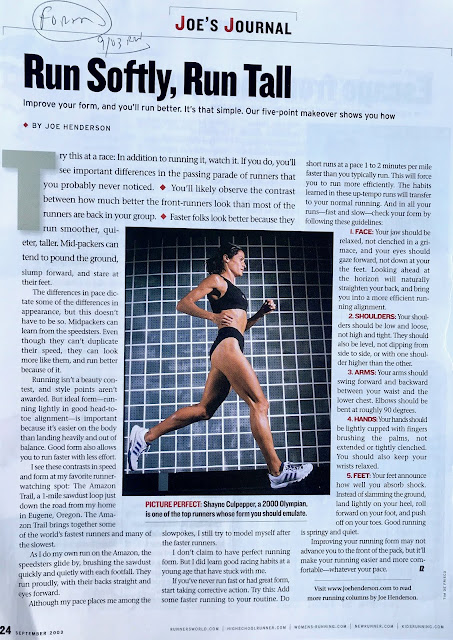(This is the 50th
anniversary of my first article in Runner’s World magazine.
All year I post excerpts from my book, This Runner’s World.)
September
2003. Stand beside a road sometime and watch a race instead of running
it. You will see in the passing parade what you might not have noticed from the
middle of it, focusing only on yourself and the runners within sight.
If you wouldn’t have been one of the lead runners, you’ll now see
how wide the gap is between their pace and where yours would have put you.
You’ll notice also how different the frontrunners look than most of those in
your group.
The faster folks typically run smoother, quieter, taller and
prouder. The slower ones pound the ground harder, and slump forward more and stare
at their feet.
The differences in pace dictate some of the differences in
appearance, but this doesn’t have to be so. Slow runners may never be able to
keep up with the fast, but can look more like them.
I don’t need to watch a race to see these contrasts in action. I
view them daily at my favorite runner-watching spot, where I’m part of the
parade but still can observe it in a leisurely way.
The Amazon Trail is a one-mile sawdust course in my hometown of
Eugene, Oregon. Runners come here by the dozens at all hours of the day and
night. This trail brings together some of the world’s fastest runners with many
of the slowest, who run one lap in the time it takes the speedsters to go two.
As they lap me, I see the faster ones gliding over the surface,
brushing it quickly and quietly with each footfall. They run proudly, with back
straight and eyes forward. Faster running almost demands that they carry
themselves this way.
Slower pace doesn’t make such demands, and bad habits can take
root in these runs. Many of the Amazon Trail runners, with their hunched backs
and downcast eyes and scraping footplants, run as if slightly embarrassed to be
seen here.
Pace places me firmly in the second group, but I still try to
model myself after the first. Faster runners hold up a picture of what the best
running form can and should be at any pace.
Slower runners naturally take shorter and lower strides, but we
still can model ourselves after those who look the best. This isn’t just advice
about looking pretty, since running isn’t not a beauty contest and no
style-points are awarded.
If form were purely an aesthetic concern, I wouldn’t bother write
about it here. It’s worth mentioning because running lightly over the ground,
in good head-to-toe alignment, is easier on the body than landing heavily and
out of balance, a thousand times every mile. It’s also a little faster for the
same level of effort.
I don’t claim picture-perfect form. But having started fast as a
young runner (racing from the first week onward), I did learn habits that have
stuck with me even while the runs have gone into slow-motion.
If you come from a similar background of speed, remember how you
looked then and try to retain it. If you’ve never run fast, or if your form has
deteriorated, start taking corrective action.
Add some faster running to your routine by way of short runs,
steady or repeated, at a pace one to two minutes per mile faster than you
typically go. This up-tempo running almost automatically forces you to run more
efficiently.
The habits learned here transfer back to your normal running. In
all runs, fastest to slowest, check your form with two tests:
Where do you
look? The back follows the lead of the head. If you watch your feet hit
the ground, you’re hunched over. But if you raise your eyes to the horizon,
your back naturally straightens and you come into more efficient alignment.
Good running is straight-backed, tall running.
What do you
hear? The feet announce how well you absorb shock. If you hear
slap-slip-scrape-shuffle, you’re hitting the ground too hard by not making full
use of ankle-flex and toe-off. The less you hear at footplant, the less likely
the ground is to hurt you. Good running is springy-stepped, quiet running.
Whatever your pace, run softly and run tall. Look like you’re
quietly proud of what you’re doing.
2018 Update. Two of the
best guides to running form reached me after this column appeared: first, Chi
Running, where I received introductory lessons from certified instructor Keith
McConnell. Second, Good Form Running, introduced to me by Curt Munson and Grant
Robison at a running camp. Abundant info on both methods is available online.
[Many books of mine, old
and recent, are now available in two different formats: in print and as ebooks
from Amazon.com. The titles: Going Far, Home Runs, Joe’s Team, Learning to
Walk, Long Run Solution, Long Slow Distance, Next Steps, Pacesetters, Run Right
Now, Run Right Now Training Log, See How We Run, Starting Lines, and This
Runner’s World, plus Rich Englehart’s book about me, Slow Joe.]



